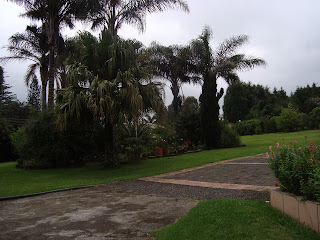Few of you have heard this story, which should have had a better ending. Last time I was in Swaziland, a little white dog, probably less than 10 pounds, turned up at the museum. She was barely alive, covered with the mange. I certainly came close to crying when I saw that the museum staff I worked with had tied her to a pole, left a bowl of water, and just ignored her. No one wanted to touch her. I acted without thinking, grabbing the sweet thing (she was so happy to have attention, she kept trying to lick my face) and headed towards the vet.
By the time I got there and the vet saw her (and gave her a shot of some sort to stop her itching) I was in tears. Then I made my way over to Swaziland's only animal rescue facility and left her there for a special shampooing and potential adoption. The next day I picked her up and brought her with me to the museum. What a cutie pie -- but so tiny, I thought I would step on her little bones and crush her flat. She was looking much better -- all the junk cleared out of her eyes (she could hardly see the day before and one eye was glued shut). Sure enough, one of my co-workers expressed interest in having her, as she liked small dogs and had two already.
I had already spoken to the rescue people about me bringing her to the USA, and they thought I would be able to without a long quaratine. But, I didn't follow up, and when this "parent" presented herself, I said o.k. -- with the caveat that Pinky (her skin was so pink under that white fur) would have a bed all her own on the porch (Swazis do not let dogs in the house. Period).
So, when I got back the other day, I asked my co-worker, how is Pinky Tuscadero? And, in a typical Swazi way, she said, well, Pinly didn't realize that "playing" with snakes was bad. Pinky was bit and died.
I always regretted that I didn't try to take Pinky home with me. I was worried about customs, having her on a 15-hour flight, etc. But, boy, I really should have. She was tiny enough to put in my handbag. RIP Pinky.

.JPG)
.JPG)
.JPG)
.JPG)

.JPG)
.JPG)
.JPG)
.JPG)
.JPG)
.JPG)
.JPG)













.JPG)
.JPG)
.JPG)
.JPG)
























